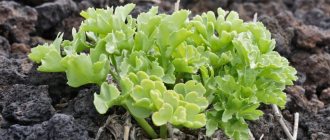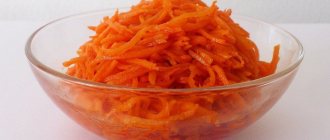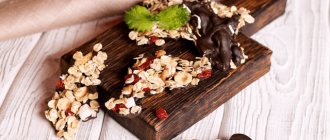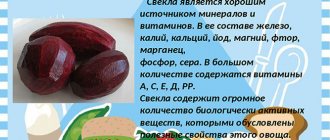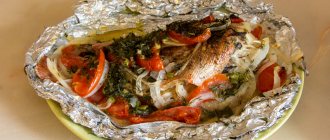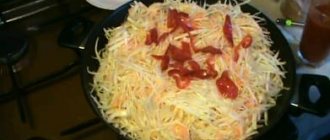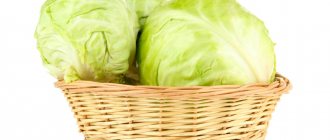Chinese lettuce, better known as Chinese cabbage or petsai, originated more than 5,000 years ago in China, gradually spreading from there throughout Southeast Asia.
This vegetable came to Europe and America only at the end of the last century, gradually becoming one of the popular products used in cooking along with white and red cabbage. The large, white-green leaves of the plant are very similar in appearance to lettuce, but have a juicier taste and tender flesh.
The low calorie content of the vegetable has made it one of the most popular dietary products.
Energy value
The calorie content of Chinese cabbage is about 17 kcal per 100 g of product. Due to its low calorie content, the vegetable is considered one of the root vegetables that have a minus energy value, since to break it down the body uses more energy than it acquires.
Chemical composition:
| Substance | Content |
| Protein | 1.3 g |
| Fats | 0.3 g |
| Carbohydrates | 2.1 g |
| Alimentary fiber | 1.3 g |
| Water | 95 g |
Beijing style fish
Ingredients:
- 3 small onions;
- 2 large porcini mushrooms;
- 6-7 leaves of Chinese cabbage;
- 700 grams of any fish;
- 2 slices ginger root;
- 2 cloves of garlic;
- 22 ml soy sauce;
- 3 tablespoons of water;
- coriander sprigs for garnish (fresh).
Preparation.
- This dish is prepared in a double boiler or slow cooker. Peel and chop the vegetables, remove the scales from the fish and divide it into 4 parts.
- Place 1/2 of the onion in the bottom of the steamer bowl. Place half the mushrooms and cabbage on top of the onions.
- Place the fish on the vegetables.
- Sprinkle ginger and garlic over our fish.
- Place the rest of the mushrooms, onions and cabbage on top.
- Pour over soy sauce and water.
- Cook for 15-17 minutes, depending on the condition of the fish.
- Garnish with coriander.
Here's how many dishes can be prepared with the addition of Chinese cabbage - from salads to side dishes and holiday dishes. Experiment and you will succeed.
Dietary properties
Chinese cabbage (the calorie content of Chinese salad is given below in the article) due to its high content of minerals and vitamins is actively used in the diet, helping to quickly regulate the digestive process and launch metabolic activity.
Daily consumption of root vegetables in a low-calorie diet helps not only to lose weight, but also:
- cleanse the blood of toxic substances;
- normalize hematopoiesis;
- prevent the formation of cholesterol plaques and stabilize physical blood pressure indicators;
- due to the large amount of vitamins A and C, it allows you to regulate protein metabolism and stabilize the redox reactions of the body;
- maintain sharpness of vision;
- normalize the functioning of the digestive and excretory systems;
- activate immunity;
- overcome chronic fatigue and anemia;
- relieve the severity and frequency of migraines;
- normalize the functioning of the nervous system;
- enrich the body with potassium, preventing the development of cardiovascular pathologies.
For women, Chinese cabbage not only helps maintain the beauty of their figure, but also, due to the large amount of indamines it contains, promotes the rapid conversion of aggressive estradiol into safe estrogen, thereby preventing the development of breast cancer.
In men, eating Chinese salad during a diet normalizes physical and mental activity, and also stabilizes cholesterol levels and prevents the occurrence of prostate cancer.
Content of vitamins and minerals:
| Elements | Compound |
| Vitamins |
|
| Macro- and microelements |
|
| Mono- and disaccharides | 15,7 |
| Essential amino acids | 0,078 |
| Nonessential amino acids | 0,89 |
| Palmic acid | 0,045 |
| Stearic acid | 0,67 |
| Palmitoleic acid | 0,004 |
| Oleic (omega-9) acid | 0,007 |
| Linoleic acid | 0,017 |
| Linolenic acid | 0,067 |
| Omega-3 fatty acids | 0,056 |
| Omega-6 fatty acids | 0,67 |
During the diet, Chinese salad helps not only stabilize weight, but also cleanse the body of toxic substances and toxins. Due to its antiviral and antiulcer properties, the use of Chinese cabbage is also indicated for people suffering from diabetes and duodenal ulcers.
Despite the abundance of minerals and vitamins, Chinese salad should be consumed in moderation.
Otherwise, an excess of vegetables in the body can lead to the appearance of:
- flatulence;
- belching;
- diarrhea;
- hypothyroidism;
- fatigue;
- hypoglycemia.
It is recommended to include dishes made from fresh Chinese cabbage in your diet, supplementing them with low-calorie vegetables, lean meats and cheese. Normally, Chinese cabbage salad should replace 1-2 snacks or be present together with protein products in one of the main meals.
Chinese salad is contraindicated for patients:
- pancreatitis;
- acute hepatitis;
- with increased acidity of gastric juice.
Not recommended for those suffering from low blood pressure and gastrointestinal hypersensitivity. Breastfeeding mothers should not eat Chinese cabbage due to the possibility of colic in the newborn.
Content of chemical elements
table 2
| Elements | Content | Daily norm |
| Iron (Fe) | 0.31 mg | 2.21 % |
| Potassium (K) | 238 mg | 6.8 % |
| Calcium (Ca) | 77 mg | 7.7 % |
| Magnesium (Mg) | 13 mg | 3.25 % |
| Manganese (Mn) | 0.19 mg | 9.5 % |
| Copper (Cu) | 36 mcg | 3.6 % |
| Sodium (Na) | 9 mg | 0.38 % |
| Selenium (Se) | 0.6 mcg | 1.09 % |
| Phosphorus (P) | 29 mg | 2.9 % |
| Zinc (Zn) | 0.23 mg | 2.88 % |
At a medium level of importance are:
- K (potassium), helps the heart muscle work and removes unnecessary fluid from the body.
- Ca (calcium) is necessary for bone and dental tissues.
- Mn (manganese) is necessary for proper cell development and iron absorption.
Low level elements of this product include:
- Fe (iron) is involved in blood formation.
- Mg (magnesium), helps increase the activity of food enzymes.
- Cu (copper) is involved in the process of hematopoiesis, growth and development of cells and tissues, and the construction of proteins.
- Na (sodium) actively participates in the formation of gastric juice for the digestion process and, together with potassium, maintains the salt composition of the blood unchanged.
- Se (selenium), protects cells from free radicals and damage, slows down the aging process.
- P (phosphorus), required by the skeletal system and teeth.
- Zn (zinc), takes part in blood formation and tissue respiration.
Difference between salad with mayonnaise and with butter
Peking cabbage (the calorie content of petsai is only 16-17 kcal, which allows Chinese salad to be included in the diet) goes well with any vegetables, fruits, and meat products. Salads should be dressed with mayonnaise or any vegetable oil.
For a dietary diet, vegetable oil or lemon juice should be added to fresh Chinese cabbage salad. Mayonnaise is a fairly high-calorie product, instantly adding more than 40 kcal to a vegetable dish. Only salads with low-calorie mayonnaise are allowed on the diet, no more than 1-3 times a week.
| Salad with mayonnaise | Energy value | 77.2 kcal |
| Squirrels | 1.9 g | |
| Fats | 6.1 g | |
| Carbohydrates | 4.2 g | |
| Salad with vegetable oil | Energy value | 55 kcal |
| Squirrels | 1.1 g | |
| Fats | 3.4 g | |
| Carbohydrates | 3.5 g |
You should not mix Chinese cabbage with sour cream or yogurt, as this combination can cause severe stomach upset.
Contraindications
Chinese cabbage can be harmful to health. Due to the high content of citric acid, people with high acidity levels should use it with caution. This can lead to acid-base imbalance, exacerbation of ulcers, pancreatitis, gastritis, colitis. Salt added to a dish of Chinese cabbage blocks the action of sulfur and chlorine, which help cleanse the intestines and can lead to internal bleeding of the stomach.
It should not be combined with fermented milk products such as cottage cheese, cheeses, because such food can cause stomach upset.
A healthy adult is recommended to eat no more than 150 g per day. Breastfeeding mothers should avoid eating Chinese vegetables in the first two months after giving birth. Infants can be introduced into the diet in small portions, gradually increasing to 100 g.
Classic recipe with butter and onions
Peking cabbage (the calorie content of the vegetable is comparable to white cabbage), eaten fresh, helps enrich the body with nutrients and vitamins, while simultaneously helping to normalize digestion and metabolic activity of the body.
Eating salads with petsai is most beneficial for people suffering from:
- gout,
- Alzheimer's disease;
- diabetes mellitus;
- nervous disorders;
- metabolic disorders;
- hepatitis.
Having a low calorie content, Chinese cabbage serves as the basis for many dietary salads.
If you are obese, it is recommended to include vegetable and Chinese cabbage salads in your diet every day, which allows you to quickly cleanse the body of toxins and toxins and reduce excess weight.
Depending on your preferences, you can use a variety of vegetable and fruit combinations. Vegetable oil or lemon juice are best suited for dressing, but low-calorie mayonnaise is allowed 1-3 times a week.
Below is a classic recipe, perfect for a diet, with a calorie content of about 19 kcal.
Ingredients:
- Chinese cabbage - 1 fork;
- red onion – 1 pc.;
- 2 tbsp. l. vegetable (or olive) oil;
- Salt.
Cooking process:
- The onion must be peeled, washed thoroughly, and then cut into quarters.
- Cabbage forks should be carefully disassembled into leaves, washed thoroughly under running water, shaken off excess moisture, and then cut into thin strips.
- Prepared vegetables should be placed in a deep plate (or salad bowl), adding 2 tbsp. l. vegetable oil and salt
- The resulting salad should be mixed well and garnished with chopped parsley.
For the salad, it is recommended to use red onions. When using regular onion, before adding it to a dish, you need to pour boiling water over it to remove the bitterness.
Chinese cabbage during pregnancy
1. Due to the high content of iodine, calcium, magnesium, potassium and iron, doctors recommend that pregnant women and nursing mothers include Peking tea in their diet.
2. Salad helps control weight, relieves swelling, normalizes blood pressure, and improves gastrointestinal function.
3. Helps relieve symptoms of fatigue.
Note! For pregnant women, the norm for Chinese cabbage is 300 g. in Week. Choose dense, beautiful, rich green heads. Before use, it is better to scald the leaves with boiling water; you can boil or stew them.
Mineral composition
The ratio of mineral substances (macro- and microelements) contained in Chinese cabbage is presented in the table using diagrams.
| Minerals, content | Share of the daily norm for 100 g | |
| Calcium | 105.0 mg | 10,5% |
| Iron | 0.8 mg | 8,0% |
| Magnesium | 19.0 mg | 4,8% |
| Phosphorus | 37.0 mg | 5,3% |
| Potassium | 252.0 mg | 5,4% |
| Sodium | 65.0 mg | 5,0% |
| Zinc | 0.2 mg | 1,7% |
| Copper | 0.0 mg | 2,3% |
| Manganese | 0.2 mg | 6,9% |
| Selenium | 0.5 mcg | 0,9% |
| Fluorine | n/a | 0,0% |
Peking cabbage, or otherwise Petsai, is a product worthy of attention, and perhaps the most wonderful and juicy variety. Every person should know that this cabbage is the best food for weight loss, and that it can be eaten every day. A small portion leads to quick saturation.
- We recommend reading: fasting day on cabbage
It is a useful vegetable for the functioning of the digestive organs, and is also low in calories, so you can eat it without restrictions and still lose weight. Petsai is rich in minerals, vitamins and fiber, and is not inferior to white cabbage.
Your feedback, comments, questions
—> —> —>—> +—>—> —>Home » Food calorie table » Vegetables and herbs » Chinese cabbage
Calories, kcal: 16 Proteins, g: 1.2 Fats, g: 0.2 Carbohydrates, g: 2.0
Peking cabbage or Chinese cabbage is the name given to a biennial vegetable crop of the Cruciferous family, mainly grown as an annual. Ripe Chinese cabbage forms an oblong cylindrical head, the leaves have a white vein at the base, and the leaves form a loose rosette. Leaf color varies from light yellow to bright green, and the leaves have wavy or jagged tips. The taste of Chinese cabbage is quite delicate, it includes the taste of cabbage and lettuce; Chinese cabbage is closest to Romaine lettuce. The leaves are juicy and crunchy, elastic, but not hard.
Peking cabbage is truly a native of China, it has been known since the 5th century AD. In China, Chinese cabbage was credited with unique beneficial properties and was considered a panacea for almost all known ailments. Today, the taste and benefits of Chinese cabbage are appreciated all over the world; it is grown in many countries, including Russia.
Calorie content of Chinese cabbage
The calorie content of Chinese cabbage is 16 kcal per 100 grams of product.
Composition and beneficial properties of Chinese cabbage
Chinese cabbage contains a large amount of indigestible dietary fiber, and there is many times more of it in the white part of the leaf than in the green part. Coarse dietary fiber plays the role of a kind of brush that collects mucus and unnecessary waste from the intestinal walls. The vegetable contains vitamin C in the green part of the leaves, known for its beneficial properties. The white part of Chinese cabbage is rich in vitamins A and K, the first of which is necessary for the production of the substance rhodopsin, which improves night vision, the second is necessary for normal blood clotting. The product contains minerals that are beneficial to the body and quite rare citric acid. Chinese cabbage normalizes the digestive tract and is an effective remedy for constipation.
Harm of Chinese cabbage
Excessive consumption of Chinese cabbage can have a negative effect on those who have problems with the digestive tract, especially increased acidity of gastric juice, gastritis and stomach ulcers. Anyone who has a “weak” intestine should introduce Chinese cabbage into their diet with caution.
Chinese cabbage for weight loss
Having a minimum calorie content, which is “negative” because the body spends more calories on digesting the product than it receives, Chinese cabbage can claim one of the leading places in the ranking of weight loss products (calorizator). By including fresh Chinese cabbage in your diet several times a week, you can stabilize and maintain your weight without diets or restrictions.
How to grow Chinese cabbage at home
Peking cabbage grows in many summer cottages, but green leaves can also be obtained at home. To do this, you need to cut off the lower white part of the head of cabbage by 5-7 cm and lower it into water until the roots appear from the stalk. Then plant it in the ground, the green leaves that appear can be eaten or wait until the seeds ripen and grow a new batch of Chinese cabbage from them.
Selection and storage of Chinese cabbage
When choosing Chinese cabbage, you need to visually assess the condition of the head of cabbage, which should be quite dense and heavy; if a large head of cabbage is light, then most likely it has been stored for too long and has dried out. The upper part of the leaves should not be weathered and have dark spots or signs of rot and mold.
You need to store Chinese cabbage in the refrigerator, you can wrap it in a dry cloth or special paper. The shelf life of the vegetable is 3-7 days, then the cabbage dries out and loses its beneficial properties.
Chinese cabbage in cooking
The healthiest thing is to eat Chinese cabbage fresh. The product is used for a variety of salads with fresh vegetables, boiled or baked meat, and crab sticks. The leaves of small-sized heads of cabbage are convenient for serving cold appetizers or portioned salads. Peking cabbage is added to soups, stews, cabbage rolls are prepared with it, and stuffed whole. It should be remembered that during heat treatment most of the beneficial substances are lost, so boiling and baking Chinese cabbage should be minimal.
For more information about Chinese cabbage, watch the video “Chinese cabbage” from the TV show “Live Healthy.”
Especially for Calorizator.ru Copying this article in whole or in part is prohibited.
Salad Recipes
For the dressing, mix half a teaspoon each of lemon juice and vegetable oil. The calorie content of this salad is approximately 15 kcal per 100 grams.
Salad with pomegranate.
A medium-sized head of fresh cabbage, a small pomegranate, 30 g of walnuts, 2 purple onions, 300–400 g of boiled chicken breast, 2 tablespoons of apple juice, olive oil and soy sauce. Boil the chicken, chop the cabbage and cut the onion into rings. Soak boiled chicken in apple juice
Peel the pomegranate and carefully remove the seeds from the peel. Grind the walnuts and mix with a drop of olive oil with the addition of soy sauce
Mix all recipe ingredients and add sauce.
Salad with shrimp
A tablespoon of sesame seeds and honey, 2 tbsp. spoons of soy sauce, and half a spoon of sesame oil, a head of Chinese cabbage, 200 g of peeled tiger shrimp, 1 pc. sweet apple.
First, boil the shrimp and let them cool. At this time, chop the cabbage and grate the apple, add shrimp to them and mix. Separately, grate sesame seeds along with honey and soy sauce, add oil and mix the salad.
Vegetable salad with Chinese cabbage
100 g of carrots, bamboo sprouts, sweet corn, and bell peppers, 300 g of cherry tomatoes, olive oil, Chinese cabbage, lemon juice if desired, sea salt.
Grate the carrots, chop the bamboo, boil or steam the corn and let cool, chop the peppers and cabbage, cut the tomatoes into halves, mix all the ingredients. Make a mixture of sea salt, lemon juice, and olive oil and dress the salad.
Beef salad.
You will need 300–400 g of beef pulp, boil it. And soak 200 g of prunes in water for 30 minutes. Chop a head of cabbage, a small sour apple, a tablespoon of olive oil.
For the sauce, grate the apple, add a tablespoon of olive oil and blend in a blender. After that, chop the ingredients as desired and mix with apple sauce.
The benefits of Chinese cabbage have been proven; it is a healthy dietary product. And it should be a must in the diet of a person losing weight!
THESE ARTICLES WILL HELP YOU LOSE WEIGHT
Your feedback on the article:
(1,046 ratings, average: 4.50 out of 5)
